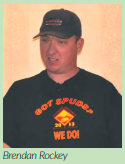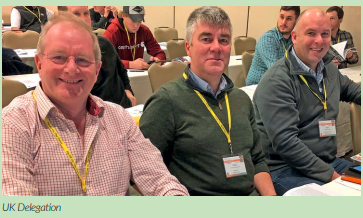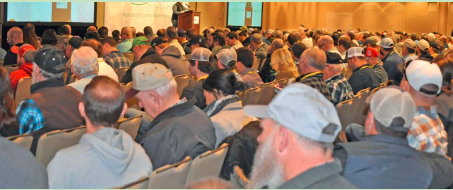Written by Ian Gould of Oakbank with contributions from David White of RTK Farming

After a successful and very worthwhile visit to the US National No-Till event in 2019 I was keen to pay heed to the many recommendations for the No Till On The Plains Conference (NTOP). This event is held in Wichita, Kansas at the end of January each year and it attracts visitors and speakers from across the world. The closest event to it in the UK would certainly be Groundswell and I know that John Cherry has been to NTOP at least once. I was delighted to be accompanied on the trip by David White who many of you will know from BASE UK, @RTKFarmer (Twitter) or from visiting Hawk Mill Farm just outside Cambridge.

Travelling is always a bit of a chore, but after a comfortable journey via Chicago we arrived in Wichita and settled into the excellent Hyatt Regency Hotel. We were met there by Russell McKenzie and Harry Henderson who were representing AHDB at the conference. The first day was an optional extra with 2 simultaneous s e s s i o n s “Fundamentals of Soil Health W o r k s h o p ” and “Advanced Concepts in Soil Health Symposium”. The UK delegation had all opted for the Advanced session and we were entertained and educated by two excellent speakers for the whole day. First up was Michael Phillips who is an Organic Orchard specialist, but his knowledge of soil microbes and Mycorrhizal Fungi (AMF) was incredibly interesting. His presentation showed lots of peer-reviewed examples of how we could be using soil biology to provide significant benefits for our crops including;
• Increased Nitrogen and Phosphate uptake
• Increased Root Health to suppress root pathogens
• Improved plant establishment, survival and growth
• Improved plant drought tolerance
• Increased Crop Yields
One of the key messages for me was how biology in the soil was essential for the stable sequestration of carbon in the soil. Macroaggregates formation is initiated by fungal hyphae enmeshing fine particles together. These macroaggregates can also form around growing roots in soils, with roots and their exudates enmeshing soil particles and stimulating microbial activity. Michael suggested that 90% of soil organic matter (SOM) is tucked away in aggregates, but the biology can still access it there. In a soil with poor aggregate structure, there is little opportunity for SOM to be retained.
A particularly poignant topic that Michael spoke about was “Fallow Syndrome”, where crops are planted into fields that were previously bare fallow for an extended period. He showed clear evidence of reduced early season growth and lower yields, compared to where cover crops had been used. The cover crops had helped to extract excess moisture from the soil, making it less anaerobic, plus they had regulated the surface temperature of the soil through shading. Both of these features are beneficial to the soil biology, not to mention the role that root exudates will play in feeding these organisms. This is clearly something to bear in mind if UK growers have fields that are prevented from Spring cropping after the recent floods, get a summer cover crop in to prepare the land for autumn planting.
With enormous respect to all the other excellent speakers, I have to say that the highlight of the whole NTOP event was the remarkable session with John Kempf who spoke about the “Principles and science of developing Regenerative Agricultural Systems”. The premise of his talk is that essentially most soil and plant ecosystems are substantially degraded, to a point where we don’t immediately recognize how severely they are malfunctioning. We don’t have a frame of reference to know what “normal” actually looks like. It is common for most crops to produce only a fraction of the yield they are genetically capable of. It is common for many plants to photosynthesize at only 15-25% of their capacity in a 24 hour photo-period.

Some take home messages from John’s talk for me were: “Biology Trumps Chemistry! Vigorous biology can overcome imbalanced chemistry, but perfect chemistry cannot deliver optimal results in the absence of biology.” Also; “Plant health is the engine that produces and increases soil health; Soil health is not an engine.” John also explained clearly how so much of the energy that is produced by photosynthesis is wasted by plants trying to make their own environment more favourable for them to grow. They expend this energy pumping out large volumes of root exudates that are specific to particular microbes which alter their rhizospere, but in better soils these resources could be used to produce more leaves, photosynthetic capacity and ultimately yield.
A significant belief of John’s is that well grown plants can be immune to pests and diseases and it is often the way in which crops are grown that encourage these problems. He gave some pretty persuasive information and examples of how his company has used this knowledge to work with growers of many types of crop and revolutionise their results.
It would be impossible to cover the huge amount of information that was delivered in his talk, at breakneck speed to get it all in, but I encourage you all to investigate John Kempf, the Regenerative Agriculture Podcast and his RegenAg Academy, where there is a plethora of information that is completely free to use. His talk alone was worth the trip to NTOP, but my brain took a battering! It was an excellent first day, rounded off by the Conference Dinner at which Jimmy Emmons spoke about his role within the USDA. Jimmy is a long-time advocate of no-till farming which he practices on his 2000 acres in Oklahoma. No-till is definitely being paid attention to by senior figures in the US government, with multi-million dollar corporations such as General Mills and Kellogg’s putting significant investments into research. Is our own government listening?
The next two days were a very well organised and run series of sessions covering a wide range of topics from some excellent speakers. The event gives delegates several chances to catch most speakers, as the talks are repeated in a rotation and most sessions run 3-4 times each. This allows the audience to engage more easily with the speakers, whilst not missing any through timing conflicts.

We all found this worked very well. I was particularly looking forward to hearing Loran Steinlage (@flolofarms) and Jason Mauck (@jasonmauck1) who are both doing ground-breaking work with inter/relay cropping and really push the envelope of how we can grow crops together. I really picked up on Loran’s comment about “Adaptation not Adoption”, we can learn from others but simply copying them is unlikely to work in your specific situation. Jason is really worth looking up on Twitter and YouTube to see the types of project he is working on, including growing wheat and soya beans in wide rows, then combining the separately. It is not just a mechanical challenge; he is constantly trying to improve the crop architecture to make this work better.
Dr Daphne Miller spoke eloquently about the link between soil, plant and human health. Her research had shown that there were significant differences in certain nutritional quality measures, depending on the production system. Her study was done on Onions in Organic and Conventional systems over a 6-year field study. She also spoke about how allergies may be a symptom of the lack of microbial diversity that people are exposed to in some environments, possibly related to their diet too.
I really enjoyed Adam Daugherty’s talk which was both entertaining and informative. Adam is a District Conservationist for the NRCS in Coffee County, Tennessee and he works closely with farmers that are transitioning to notill. His slightly irreverent talk suggested that the biggest agricultural export in the US was Soil! Adam stated that we are all farming fields that have some degree of degradation, some are worse than others, but all share the potential for rejuvenation. However, we cannot progress positively if we are in denial of why the problems occurred.
One of the most memorable speakers was Brendon Rockey who grows potatoes in Colorado. Brendon describes his methods a Biotic farming, stating that your tools can be either Anti-biotic or Pro-biotic. Rockey Farms is not Organic, but they use no insecticides, fungicides and almost zero herbicides or fertilisers. Instead they use natural methods, such as in-crop strips and companion crops of pollinator species to encourage predatory insects to control Aphids. Rockey Farms produces seed potatoes that have a zero tolerance for viruses and their methods are working extremely effectively, improving product quality and profitability. Considering where Brendon farms, their climate and their market, what they are achieving is outstanding!
There were many other good talks, but I wanted to cover what our UK delegation got from the conference and what actions we were planning to take once we got home.
David White recalled that he will use the term Regenerative Agriculture more as it describes what he is doing better than “Conservation”, moving away from a monoculture and removing as many “-cides” from his farm as possible. David will also focus on getting a better balance of fungus vs bacteria in his soils, whilst learning to be patient and sit on his hands a bit more, giving nature a chance to help him first. He also really enjoyed the camaraderie of all the delegates, all happy to share their thoughts and experiences for mutual benefit of the farmers, soil and wider community.
Russell McKenzie spoke about the key being incorporating Diversity as much as possible, getting away from one-dimensional thinking and being prepared to try something different. He explained that he would be looking at ways of using Companion Crops in different ways on his farm, as well as introducing more pollinator strips to bring beneficial insects to the heart of his fields. This could be part of a Countryside Stewardship Scheme, to take away some of the financial burden on these endeavours. Harry Henderson is the Knowledge Exchange Technical Manager for AHDB and he had some interesting thoughts about how technology such as Small Robots would work well in a regenerative system. The lack of a requirement for horsepower hungry cultivation, etc would really lend itself to smaller, lighter machinery. Harry was also keen to take back a lot of learning points to the AHDB and incorporate them in innovative trials to adapt the US work to UK conditions, in conjunction with like-minded growers and manufacturers.
From my point of view the need for diversity in all things really struck home, many of the benefits are well-recognised and perhaps only partially understood. The importance of the key principles of Regenerative Agriculture (soil cover, living roots, lack of soil disturbance (physical and chemical), incorporate livestock) continued to both make sense and be backed up by science. In terms of what I plan to do, the answer to many of the challenges came back to improving your soil biology and organic matter. This can be done very successfully using living roots from companion and cover crops, but we need more experience about what works reliably in our conditions. I am lucky to have a growing network of farmers that are keen to try these ideas for themselves and we will be sharing our findings.
To sum up our trip to NTOP was great value, full of new ideas and new friends to learn from over the years ahead. We would all urge you to consider a visit to the 2021 event if you have an interest in pushing your own farm forward down the regenerative path. Be under no illusion, the profit motive was very important for all the growers, but it was seen as a consequence of a more sustainable, lower risk and definitely more diverse way of farming.
